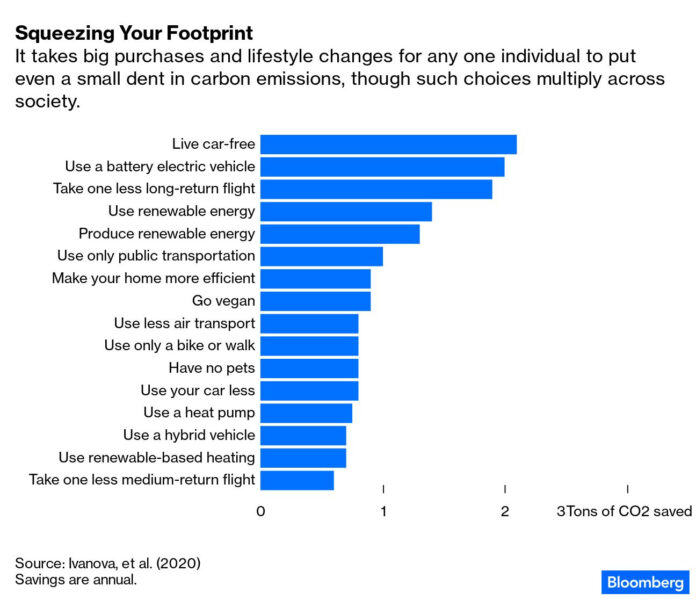In a newsletter I subscribe to produced by Bloomberg, called Greener Living, I saw the graph that appears above entitled Squeezing Your Footprint. It represents a compilation of responses from climate scientists and politicians asking them about their guilty pleasures, habits, hobbies, way of life, and ways they were decarbonizing.
Savings made by lifestyle choices show how much carbon dioxide (CO2) is being removed from the atmosphere for each of the 16 categories shown on the graph. If it serves your purpose, you may want to look at the list and see how each of your life choices compares in terms of CO2 saved. I know I did a quick inventory and compared my wife and me to the items displayed on the graph.
These are my conclusions about our lifestyle choices and reducing our CO2 output:
- We are not living car-free. We use it far less and try to take public transit when going into Toronto. When we do use the car we make each trip fulfill multiple tasks.
- Our car is a hybrid, not an electric one. Before we moved to Oakville, our apartment had no EV charge stations. The place we live in now does and when we get our next vehicle we will look at either a hybrid plug-in or pure EV.
- We are using the regional GO train to go to Toronto and accessing mass transit to go to medical appointments and to meet friends.
- The building we live in is powered by a heat pump. Our apartment uses a heat pump.
- Our kitchen appliances are all new energy-efficient models.
- The power provider to the building is delivering green electricity.
- In our recent move, we have downsized the space in which we live. At the same time, we have decluttered, repurposed and given away technology we no longer are using rather than trash or recycle it.
- After our dog, Maya died, two years ago in August, we no longer have plans to get another pet.
- We haven’t been on an airplane since December 2022. It was our first trip in three years by airplane. I must confess we have a wedding in the Rocky Mountains this summer and will have to fly to get there. For next winter we would like to go to Southern Spain for a month next winter to somewhere sunny and warm.
- We eat less meat, especially red meat, but cannot claim to be leaning toward a vegetarian or vegan lifestyle, although we are eating far smaller portions than ever before. Maybe smaller portions mean less of a carbon footprint.
- We don’t throw out old clothes but clean them and give them away.
- We reuse and recycle almost everything that comes through the front door including newspaper, plastic, aluminum, paper products, and kitchen organic waste.
- We shop locally having moved to a place with a grocery and drugstore next door.
I don’t consider myself low-carbon virtuous although I aspire to attain a low-carbon lifestyle whenever possible.
My wife and I’s personal vice is an addiction to reading things in print, which means we subscribe to two daily newspapers and a weekly news magazine. One hopes the paper used is recycled. I know we recycle all of it after reading.
About other reading materials, we stopped buying hardcover books some time ago and now only get e-books.
Our one other vice is using Amazon for stuff unavailable at local shops.
Making lifestyle choices based on our carbon footprint is not easy. That’s because reducing personal carbon footprints is hard work. What we have done is the bare bones because we both are retired and at a stage in life where stuff no longer defines us. For others, however, getting the carbon footprint smaller is much harder.
I’ll give you an example of carbon footprint challenges. My daughter and son-in-law bought a more than 100-year-old home in Toronto two years ago. It needed upgrading of the insulation, windows, doors, heating, cooling, and more. These were significant investments even though the federal government had launched an energy efficiency grant and low-interest loan program to help with energy efficiency upgrades for residential homeowners. One challenge of being dependent on government incentives like these is that you have to do a lot of paperwork, wait for approvals, and pay out-of-pocket before you get reimbursed. That can put a lot of stress on a family budget.
Other family considerations when making decarbonizing decisions include visits. Today, virtual visits have become more common after the onset of the COVID-19 pandemic. These online visits are not the same as seeing family in person. The difference between them has psychological consequences. Going for a visit often requires the use of a car, particularly if public transit requires multiple transfers and a significant amount of extra time.
What was not on the list of the 16 CO2-saving lifestyle choices that surprised me was carbon savings from planting a food garden. Victory gardens were planted during World War 2 because of food shortages. The tradition of having a small vegetable patch, or a fruit tree in the backyard continues. Another confession: we have a grapefruit tree in our apartment with a near-full-size grapefruit hanging off a branch.
Does planting a vegetable garden reduce our CO2 footprint? Apparently not. It turns out it is an urban myth. A January 22, 2024 article in the journal Nature Cities, provides evidence that shows CO2 contributions from urban agriculture are six times greater than that produced by conventional farms or greenhouse operations.
Only tomatoes and peppers when grown in backyards and on balconies can help reduce CO2 footprints. There is good news. Urban vegetable growers love tomatoes. They constitute 25% of what we plant in our city backyards and on balconies. For urban gardeners who love tomatoes, if you add composted organics and use rainwater you can reduce your carbon footprint even more.
















